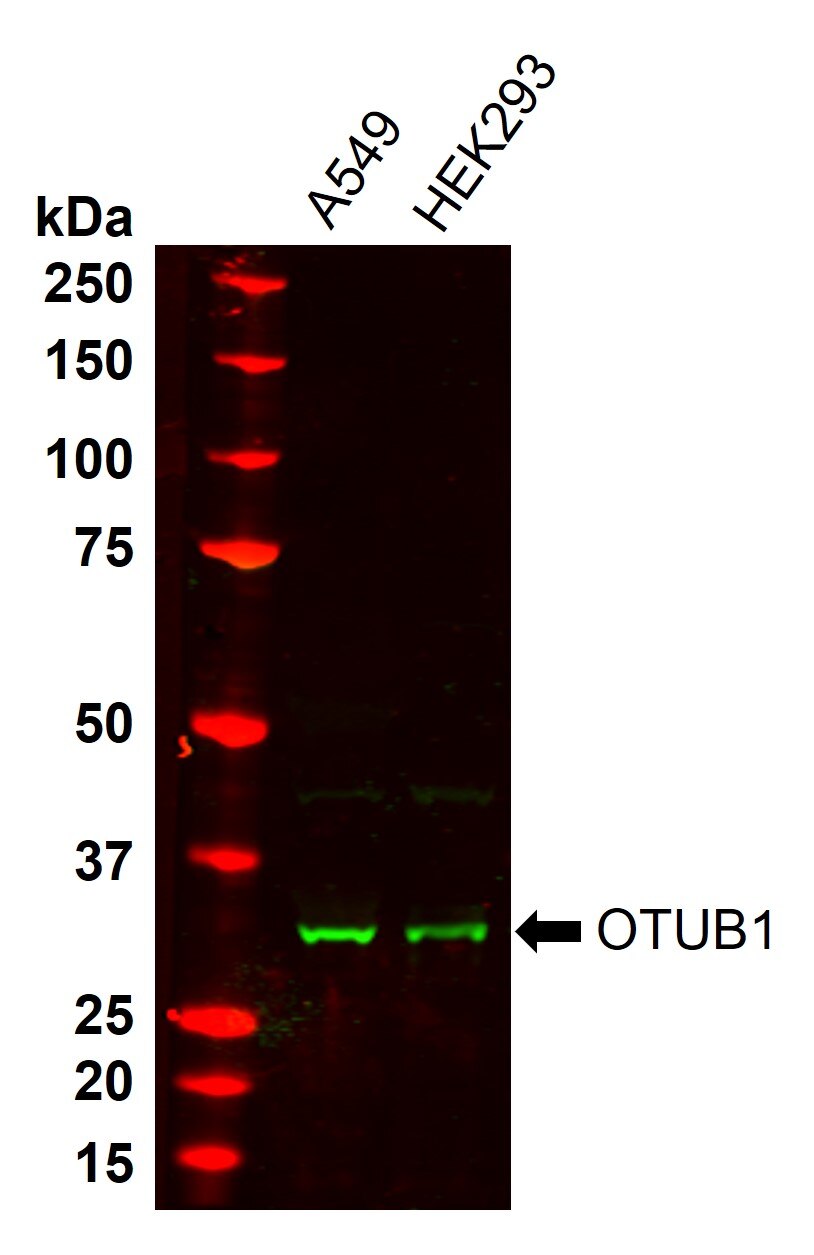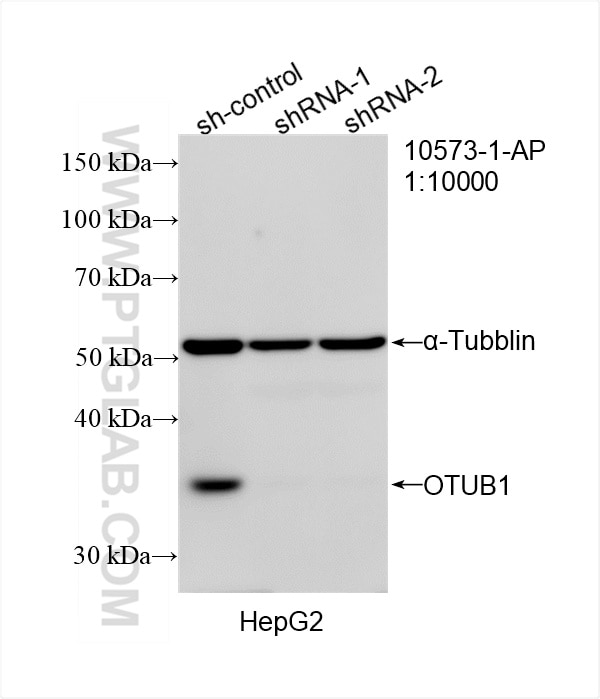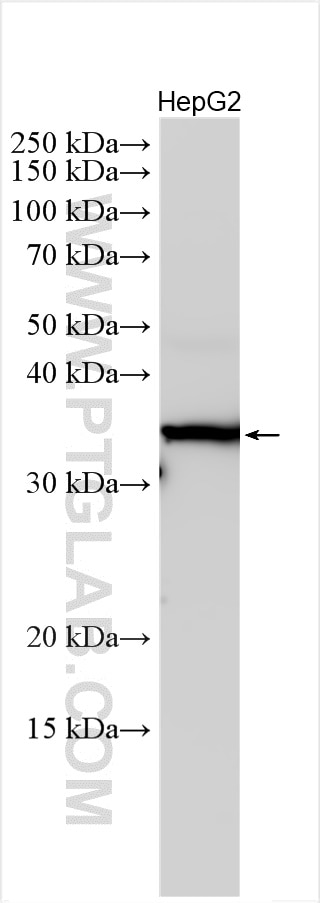- Featured Product
- KD/KO Validated
OTUB1 Polyklonaler Antikörper
OTUB1 Polyklonal Antikörper für WB, IF/ICC, ELISA
Wirt / Isotyp
Kaninchen / IgG
Getestete Reaktivität
human, Maus, Ratte
Anwendung
WB, IF/ICC, IP, CoIP, RIP, ELISA
Konjugation
Unkonjugiert
Kat-Nr. : 10573-1-AP
Synonyme
Geprüfte Anwendungen
| Erfolgreiche Detektion in WB | MCF-7-Zellen, HepG2-Zellen, Maushirngewebe, Maus-Cerebellum-Gewebe, Rattenhirngewebe |
| Erfolgreiche Detektion in IF/ICC | U2OS-Zellen |
Empfohlene Verdünnung
| Anwendung | Verdünnung |
|---|---|
| Western Blot (WB) | WB : 1:500-1:3000 |
| Immunfluoreszenz (IF)/ICC | IF/ICC : 1:200-1:800 |
| It is recommended that this reagent should be titrated in each testing system to obtain optimal results. | |
| Sample-dependent, check data in validation data gallery | |
Veröffentlichte Anwendungen
| WB | See 4 publications below |
| IF | See 2 publications below |
| IP | See 1 publications below |
| CoIP | See 1 publications below |
| RIP | See 1 publications below |
Produktinformation
10573-1-AP bindet in WB, IF/ICC, IP, CoIP, RIP, ELISA OTUB1 und zeigt Reaktivität mit human, Maus, Ratten
| Getestete Reaktivität | human, Maus, Ratte |
| In Publikationen genannte Reaktivität | human, Maus |
| Wirt / Isotyp | Kaninchen / IgG |
| Klonalität | Polyklonal |
| Typ | Antikörper |
| Immunogen | OTUB1 fusion protein Ag0845 |
| Vollständiger Name | OTU domain, ubiquitin aldehyde binding 1 |
| Berechnetes Molekulargewicht | 31 kDa and 35 kDa |
| Beobachtetes Molekulargewicht | 31-35 kDa |
| GenBank-Zugangsnummer | BC007519 |
| Gene symbol | OTUB1 |
| Gene ID (NCBI) | 55611 |
| Konjugation | Unkonjugiert |
| Form | Liquid |
| Reinigungsmethode | Antigen-Affinitätsreinigung |
| Lagerungspuffer | PBS with 0.02% sodium azide and 50% glycerol |
| Lagerungsbedingungen | Bei -20°C lagern. Nach dem Versand ein Jahr lang stabil Aliquotieren ist bei -20oC Lagerung nicht notwendig. 20ul Größen enthalten 0,1% BSA. |
Hintergrundinformationen
OTUB1 belongs to the ovarian tumor domain protease (OTU) subfamily of deubiquitinases, which could block ubiquitination leading to protein stability. OTUB1 mainly prefers k-48 and k-63 ubiquitin chains type, especially in k-48 ubiquitin chain. OTUB1 performs its deubiquitinating function via two distinct manners: the canonical and non-canonical manner. OTUB1 is involved in many critical immune response processes, containing CD8 T cell activation, PD-L1 related immune evasion, and several infectious diseases. OTUB1 plays an important role in the occurrence, proliferation, invasion, and progression of various cancers, such as bladder cancer, breast cancer, prostate cancer, and colorectal cancer (PMID: 34875341, 35296795). OTUB1 has 2 isoforms with molecular weights of 31 and 35 kDa, respectively. With phospho or ubiquitin modification or reaction, the MW of OTUB1 will be increased.
Protokolle
| PRODUKTSPEZIFISCHE PROTOKOLLE | |
|---|---|
| WB protocol for OTUB1 antibody 10573-1-AP | Protokoll herunterladen |
| IF protocol for OTUB1 antibody 10573-1-AP | Protokoll herunterladen |
| STANDARD-PROTOKOLLE | |
|---|---|
| Klicken Sie hier, um unsere Standardprotokolle anzuzeigen |
Publikationen
| Species | Application | Title |
|---|---|---|
Adv Sci (Weinh) Primary Cilia Formation Mediated by Hsa_Circ_0005185/OTUB1/RAB8A Complex Inhibits Prostate Cancer Progression by Suppressing Hedgehog Signaling Pathway | ||
Biochem Pharmacol OTUB1 enhances fatty acid oxidation in APAP-induced liver injury by mediating ACSL5 deubiquitination | ||
ACS Pharmacol Transl Sci Bruceine B Displays Potent Antimyeloma Activity by Inducing the Degradation of the Transcription Factor c-Maf | ||
Exp Cell Res OTUB1 mediates PARP1 deubiquitination to alleviate NAFLD by regulating HMGB1 | ||
Sci Rep CircSCD1 inhibits ferroptosis in breast Cancer through stabilizing SCD1 protein via deubiquitinase OTUB1 |
Rezensionen
The reviews below have been submitted by verified Proteintech customers who received an incentive for providing their feedback.
FH Angie (Verified Customer) (04-09-2024) | The antibody detected a band between 25 and 37 kD at dilution of 1:3000 incubated at room temperature for 2 hours. This is followed by secondary antibody donkey-anti-rabbit (Alexa Fluor 800) used at 1:20000 dilution and incubated for 1 hour at room temperature.
 |





